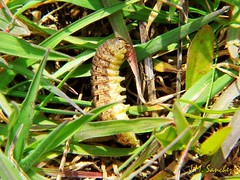
Reino: Animalia:
Phylum: Arthropoda:
Clase: Insecta:
Orden Lepidoptera:
Familia: Noctuidae
Es una especie abundante a través de Europa, una de las polillas mas comunes y más familiares de la región. En algunos años la especie es migratoria. Es una polilla grande y pesada con un envergadura de 50-60 milímetros. Las alas delanteras son marrón claro casi ennegrecerse. Los individuos más oscuros tienen a menudo una raya pálida a lo largo del borde. Las alas posteriores son naranja-amarillosbrillante con una banda negra del . Como con otras especies de Noctua , este contraste de neutro en descanso y brillantel brillante en vuelo se utiliza para confundir a losdepredadores potenciales. Esta especie vuela en la noche a partir de julio a septiembre y acude a la luz a veces en bandadas enormes La larva es verde o marrón con dos filas de manchas negras a lo largo de la parte posterior. Causan daños fatales en la base de virtualmente cualquier planta herbácea , separándolas a veces totalmente. Se ha visto sobre:
Dahlia, zanahoria, crisantemo, Brassica, remolocha, gladiolo, lechuga, fresa, tomate, Primula, ruibarbo, patata, espinaca, diente de león, violeta, uva...
(traducido de Wikipedia)
English:
The Large Yellow Underwing (Noctua pronuba) is a moth, the type species for the family Noctuidae. It is an abundant species throughout Europe, one of the commonest and most familiar moths of the region. In some years the species is highly migratory with large numbers appearing suddenly in marginal parts of the range.
This is a quite large and heavy moth with a wingspan of 50-60 mm. The forewings are quite variable from light brown to almost black. The darker individuals often have a pale streak along the costa. The hindwings are bright orange-yellow with a black sub-terminal band. As with other Noctua species (and numerous other insects), this contrast of drab-at-rest and bright-in-flight is used to confuse potential predators. This species flies at night from July to September [1] and is attracted to light, sometimes in huge numbers. It will also visit flowers such as Buddleia, ragwort and Red Valerian.
The larva is green or brown with two rows of black dashes along the back. This is one of the notorious "cutworms", causing fatal damage at the base of virtually any herbaceous plant (some examples listed below), sometimes severing it completely. This ubiquitous species is one of the most hated of garden pests. The species overwinters as a larva and feeds on mild days throughout the winter.
1. ^ The flight season refers to the British Isles. This may vary in other parts of the range.
Recorded food plants
* Allium
* Beta - Beet
* Brassica
* Calendula - Marigold
* Chrysanthemum
* Dahlia
* Daucus - Carrot
* Dianthus - Carnation
* Fragaria - Strawberry
* Freesia
* Gladiolus
* Hieracium - Hawkweed
* Lactuca - Lettuce
* Lycopersicon - Tomato
* Plantago - Plantain
* Poaceae - Grasses
* Primula
* Rheum - Rhubarb
* Solanum - Potato
* Spinacia - Spinach
* Taraxacum - Dandelion
* Viola - Sweet violet
* Vitis - Grape
(From Wikipedia: Thanks)
No hay comentarios:
Publicar un comentario